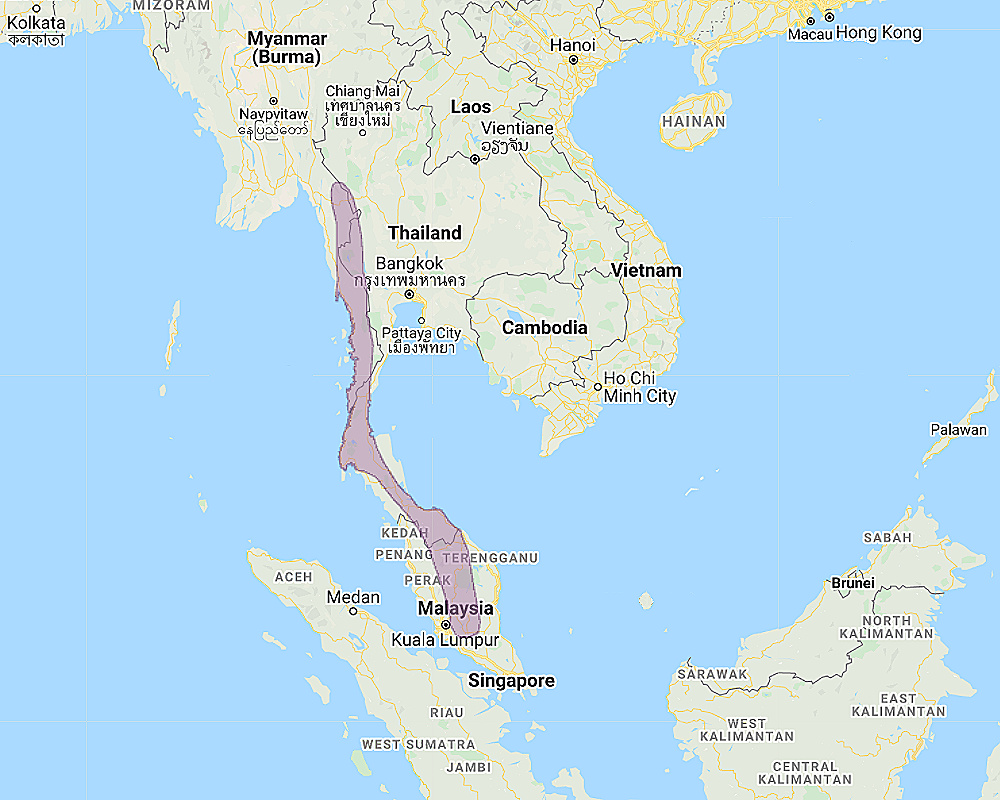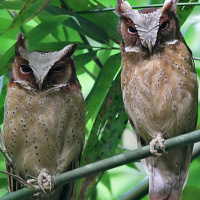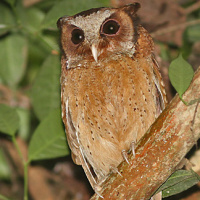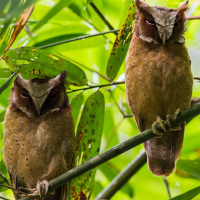Introduction
The White-fronted Scops Owl is relatively large for a scops owl, and has a relatively long tail and rounded wings. It has a prominent white forehead which extends into the large ear-tufts.
Photo Gallery (4 pictures)
Sound Gallery
Information
Description: The facial disc is pale rufous, with a broad ring of deep rufous-chestnut feathers around the eyes, and bordered by
black-tipped feathers. The forehead and superciliary stripe extend to the ear-tufts, and are white with a pinkish tinge, obscurely vermiculated with
fuscous. Eyes are deep brown to dark honey-brown with pink eyelids. The bill is bluish-white, and cere pale-bluish-green. The bristles around the base
of the bill are whitish with black tips. A patch of close-set, pinkish-white, black-tipped feathers form a partial ruff extending from the chin to above
the gape line.
Upperparts are rufous-chestnut, with the mantle and back having small, triangular, buffish-white spots with a black lower margin. The inner scapulars
have similar but larger spots, and the outer scapulars are yellowish-white to rufous on the outer webs, with 3-4 moderately sized black spots on the
shafts. The wings are rounded, with the ground colour similar to the back, with some darker and paler brown bars. The tail is chestnut-rufous with about
ten transverse blackish bars that are more distinct on the outer feathers and towards the base.
Underparts are pale rufous, finely vermiculated with brown on the breast and throat, and each feather having a pale or whitish centre broken by a roundish
black shaft-spot, the largest being on the centre of the belly.
Tarsi are feathered rufous. Toes are flesh-pink and claws bluish-white.
Size: Length 25-28cm. Wing length 175-192mm. Tail length 108-125mm. Weight 109-130g.
Habits: The White-fronted Scops Owl is a little known and elusive bird.
Voice: A vibrating hollow tremolo, lasting 13-14 seconds, rising somewhat in volume and ending quite abruptly -
wuwuwuwuwuwuwu... (Robson).
The song of the male is a hollow whistle, beginning and ending abruptly and repeated at long intervals - hoooooo (König et al.)
Hunting & Food: The White-fronted Scops Owl feeds on insects, mostly moths.
Breeding: Little known. Breeding season in Thailand and Malay Peninsula is from February to March. Nests in tree holes. Clutch size is 3-4 eggs that are white and roundish, averaging 34.2 x 28.5mm.
Habitat: Evergreen forest and degraded swampy forest. Found in rainforest or tall secondary forest in lowlands and hills of Malay Peninsula, where it occurs from about 600-700m elevation.
Distribution: Peninsular Burma, Peninsular Thailand and Malay Peninsula.

Range of the White-fronted Scops Owl Otus sagittatus
Status: Listed as Vunerable by Birdlife International.
Original Description: Cassin, John. 1849. Proceedings of the Academy of Natural Sciences of Philadelphia, 4 (1848), p. 121-123.






